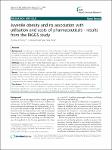Juvenile obesity and its association with utilisation and costs of pharmaceuticals - results from the KiGGS study
Wenig, Christina M.
Knopf, Hildtraud
Menn, Petra
Background: According to a national reference, 15% of German children and adolescents are overweight (including obese) and 6.3% are obese. An earlier study analysed the impact of childhood overweight and obesity on different components of direct medical costs (physician, hospital and therapists). To complement the existing literature for Germany, this study aims to explore the association of body mass index (BMI) with utilisation of pharmaceuticals and related costs in German children and adolescents. Methods: Based on data from 14, 836 respondents aged 3-17 years in the German Interview and Examination Survey for Children and Adolescents (KiGGS), drug intake and associated costs were estimated using a bottom-up approach. To investigate the association of BMI with utilisation and costs, univariate analyses and multivariate generalised mixed models were conducted. Results: There was no significant difference between BMI groups regarding the probability of drug utilisation. However, the number of pharmaceuticals used was significantly higher (14%) for obese children than for normal weight children. Furthermore, there was a trend for more physician-prescribed medication in obese children and adolescents. Among children with pharmaceutical intake, estimated costs were 24% higher for obese children compared with the normal weight group. Conclusions: This is the first study to estimate excess drug costs for obesity based on a representative crosssectional sample of the child and adolescent population in Germany. The results suggest that obese children should be classified as a priority group for prevention. This study complements the existing literature and provides important information concerning the relevance of childhood obesity as a health problem.
Dateien zu dieser Publikation
Keine Lizenzangabe

